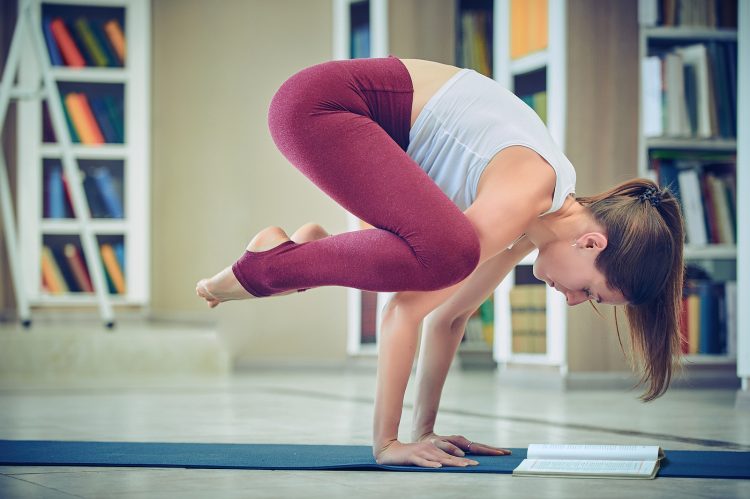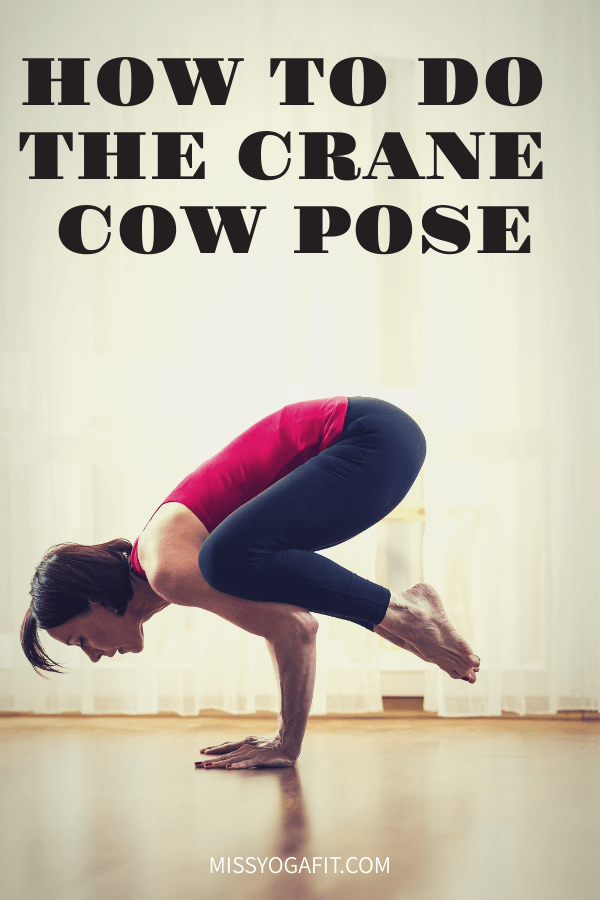
Crane-cow Pose acts like an arm balance. The pose helps to build the arms and the abs.
POSE INFORMATION
GENERAL INFO
Name in Sanskrit: Bakasana
Difficulty: Medium
POSE BENEFITS
- This pose makes the arms and fits stronger.
- It widens the groins
- It flexes the upper back a little.
- It helps tone the organs of the abdomen.
POSE CAUTIONS
The following health issues should take cautions from the exercise:
- People who suffer from carpal tunnel syndrome.
- Pregnant women.

HOW TO PRACTICE THIS ASANA
ONE
Start with the Todasana. Squat with your feet some inches from the each other. When it’s difficult to keep your feet on the floor, fold a blanket and place it under them.
In your squatting position, move your knees apart from your hips. Push your torso forward within your thighs.
Extend your hands forward and fold the elbows. Put your hands down on the floor and your upper arms should be at the back of your shins.
TWO
Move your torso comfortably against the inner of your thighs. Then move your shins inside your armpit.
Push your hands down to the base of your shin. Push up to the balls of the shin and push your body forward than before. This will carry the weight of your body to the upper arms.
This pose aims to compress the body and round the back totally. The best way to achieve this is by keeping the tail bones close to the heels as possible.
THREE
Breathe out and push your body to the front the and o the back of your upper arms more as you go through the process.
Notice when the balls of your feet begin to leave the floor. This means your body and your body are on the same balanced phase, the back of your upper arms.
Beginners should stop here unless they could perform the next process.
FOUR
The next step if you want to continue the process is to press the legs against the arms.
Stay tight in the position with your hands on the floor, breathe out, and extend your elbows straight. Notice the elbows are in a slight angle in relation with the floor.
Ensure that the inner of your thighs is attached to the outside of your arms near the armpit. Let the head be in a sable position where you can look at the floor.
Alternatively, you can push your head upward, and avoid contracting the back of the neck and look towards the front.
FIVE
Maintain this position between 20 seconds and 1 minute.
Then you can relax and fall back into the squatting position to release your body from the pose.
How to do the the Crane-Cow Pose (Bakasana)
BEGINNER TIPS
As a beginner, it is likely you will move your buttocks away from your heels. However, the pose requires you to snuggle tight and stay in that position. Your heels should be kept close to your buttocks.
To move your feet up during the pose, press the upper arms to your shin and move your inner groins into the pelvis. This will assist you to take your feet off he floor.
MODIFICATIONS & PROPS
The first difficulty beginners might experience is to lift up off the floor into the pose.
To make easy, participants should place a block under your squatting position. Therefore, you will be a few inches off the ground when practicing.
DEEPENING THE POSE
You will feel some pressure on your wrist during practice.
Now spread your fingers off the ground and curve them a little to reduce the pain you might feel.
PARTNERING
Earlier, it is said that the first difficulty is lifting off the floor. A partner can help you with this. When in your squatting position and you want to lean forward, let your partner stand in front of you and assist you from falling over your face.
They will support your shoulders with her hands. Then remain in the pose and under your partner’s support for a few breaths.
VARIATION
The first variation to the Crane-cow pose (Bakasana) is the Parsva Bakasana (the pronunciation is PARSH — which means side or flank.
This starts with squatting, and keeping your knees close together. In this position, breathe out and face your body to the right side.
Support the left elbow with the outside of the left knee.
Now run the arm beside the knee until he knee is strong against the upper arm towards the armpit.
Place the hands on the floor. Push to the right, breathe out and carry the feet up. Balance your position with upper left arms pressed against the outer right leg.
Extend the hands straight as much as you can. His might be difficult for most participant, the elbows will be slightly bent.
Stay in this pose for 20 – 30 seconds, breathe out and return to your squat, then do the sme to your left for 20-30 seconds.
Jennie Malt, a certified Yin Yoga teacher residing in Canada, has been on a remarkable journey of discovery and transformation through the practice of yoga.
Her path, though not one of fame and influence, is a testament to the profound effects of dedication and the capacity of yoga to inspire and uplift.

